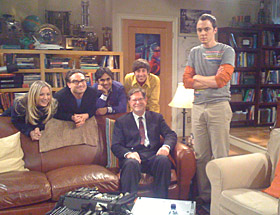Paul Richards, George Smoot honored for astrophysics research and teaching
| 23 February 2009
BERKELEY — Two University of California, Berkeley, physicists – Paul Richards and Nobel Laureate George Smoot – have been honored for their contributions to astrophysics research and teaching.

George Smoot on the "Big Bang" set with (from left) Penny, Leonard, Raj, Wolowitz and Sheldon
Cosmologist George Smoot meets TV's 'Big Bang' nerds
Nobel Laureate George Smoot, a trifle nerdy himself, couldn't resist an invitation to make a cameo appearance on the TV sit-com about the ultimate nerds, "The Big Bang Theory." So last week, Smoot, an admitted fan of the series, dropped everything and flew to Warner Brothers Studios in Burbank to meet the crew and, on Feb. 18, filmed a segment that will air March 9 on CBS.
For those unfamiliar with the series, the premise of "The Big Bang Theory" is that two brilliant Caltech physicists, Leonard (Johnny Galecki) and Sheldon (Jim Parsons), are so socially inept that they have trouble relating to "a free-spirited beauty" named Penny (Kaley Cuoco) who moves in next door.
Smoot makes an appearance when Leonard, Sheldon and two friends take a train from Los Angeles to San Francisco to attend a conference where Smoot is the keynote speaker. While Sheldon hopes to give Smoot a paper he has been working on, Leonard lusts after another passenger, Summer Glau, the sci-fi actress who makes a regular appearance as an android on the television show "Terminator: The Sarah Connor Chronicles."
While on the set, Smoot and crew met with reporters from Science magazine and the Pasadena Weekly, and Smoot snagged a camera-phone picture showing him with the cast. Sheldon is the one who looks peeved that George sat down in his spot on the couch. Tune in next week to see if Sheldon meets George and Leonard meets Summer.
Smoot, professor of physics and a research physicist at Lawrence Berkeley National Laboratory, was honored with the Oersted Medal by the American Association of Physics Teachers. The annual medal, which has been awarded since 1936, comes with $10,000 and "recognizes those who have had an outstanding, widespread, and lasting impact on the teaching of physics," according to the association.
Richards organized and led the international collaboration known as the Millimeter Anisotropy eXperiment IMaging Array (MAXIMA), which measured temperature fluctuations in the cosmic microwave background radiation – the low-temperature glow left over from the Big Bang. From these measurements, reported in 2000, Richards and his colleagues deduced that the universe has a flat, Euclidean geometry and found evidence for cosmic inflation, that is, a rapid expansion of the universe that occurred a fraction of a second after the Big Bang.
The results also confirmed that the visible matter in the universe makes up only 5 percent of the matter and energy in the universe. The remainder is either cold dark matter – the unseen mass that holds galaxies together – or dark energy, a mystifying pressure or repulsive force that seems to be accelerating the expansion of the universe.
The experiment paralleled de Bernardis and Andrew Lange's Balloon Observations Of Millimetric Extragalactic Radiation and Geophysics (BOOMERanG) experiment.
"Sharing the award with my good friends Andrew Lange and Paolo de Bernardis makes a lot of sense, since the three of us collaborated and competed to various degrees on the MAXIMA and Boomerang experiments, both of which were published in the spring of 2000," Richards wrote in an e-mail from Costa Rica, where he was vacationing. "Together (these experiments) ushered in the era of precision cosmology. Both experiments began when Lange was a post-doc in my group in Berkeley and continued when he was an assistant professor."
Lange is now the Goldberger Professor of Physics at the California Institute of Technology in Pasadena. De Bernardis is a professor of physics at the University La Sapienza in Rome, Italy.
Richards, who has been a UC Berkeley faculty member since 1966, is a member of the National Academy of Sciences, the American Academy of Arts and Sciences, the American Physical Society and Phi Beta Kappa. His awards include the Frank Isakson Prize for Optical Effects in Solids; the Button Medal for Outstanding Contributions to the Science of the Electromagnetic Spectrum; and the Department of Energy Award in Solid State Physics for Outstanding Scientific Accomplishments. He was named California Scientist of the Year in 1981.
Smoot, who joined the UC Berkeley faculty in 1994, won the Nobel Prize in Physics in 2006 for his work with NASA's John Mather on the Cosmic Background Explorer (COBE) satellite, which made the first measurements of temperature fluctuations in the microwave background radiation and set the stage for later measurements by the recipients of the Dan David Prize. Among his many awards are the Gruber Prize, the Einstein Medal of the Albert Einstein Society and the Department of Energy's Ernest O. Lawrence Award. He is a member of the National Academy of Sciences.
For more information, link to the Dan David Prize Web site.

